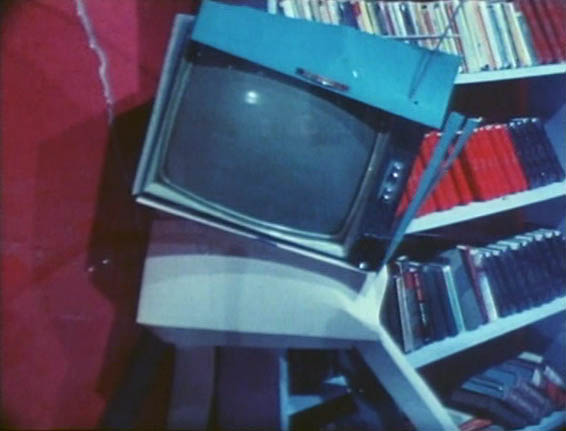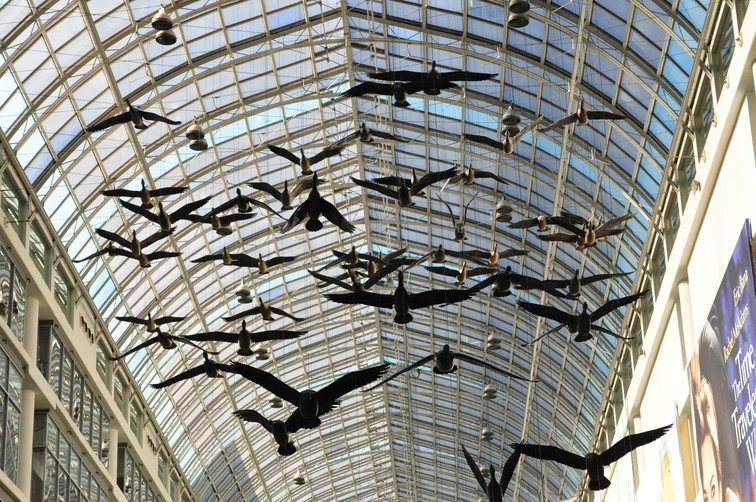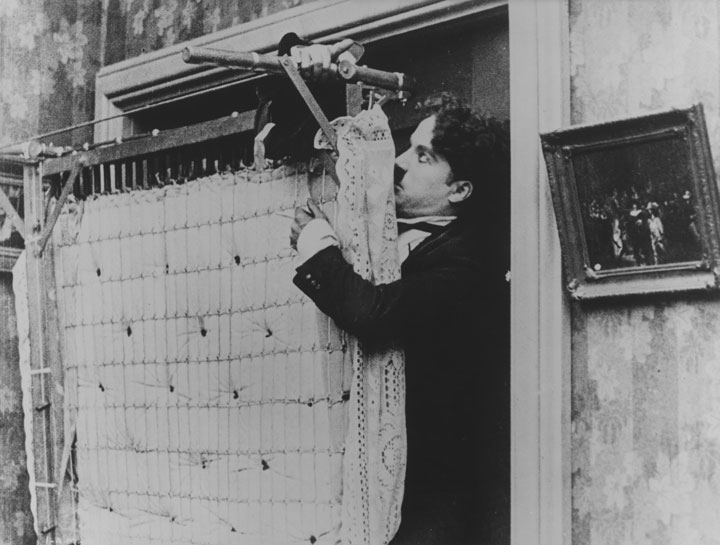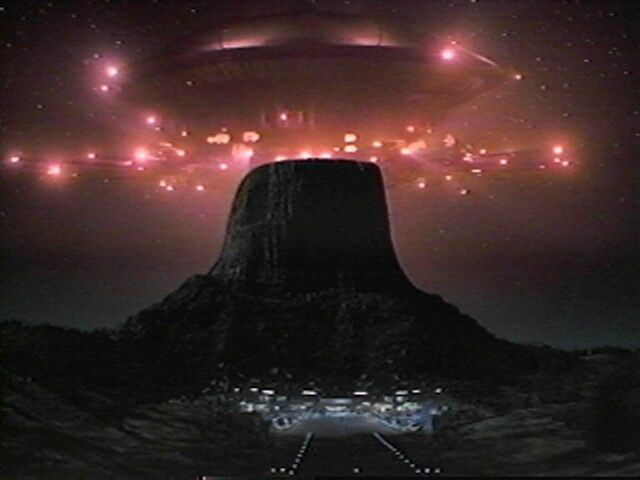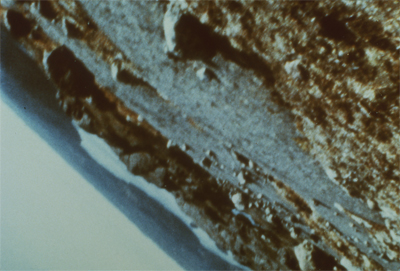I conducted two interviews with Michael Snow in the early 1980s. The first of these, commissioned by Film Comment‘s Richard Corliss (who sent me to Toronto in order to do it), was about Snow’s film Presents and ran in the magazine’s May-June 1981 issue. The second was commissioned by Simon Field’s excellent English magazine Afterimage. Both of these interviews were delightful experiences for me, and I feel privileged to have been treated by Snow during this period as a friend. (For a short while, I used to visit him once a year, whenever I came to the Toronto International Film Festival, and loved getting stoned with him — and then, most often, going to Chinatown for dinner.) —J.R.
The “Presents” of Michael Snow
A Breathless Intro
Lower Manhattan, 1981, the opening of a Canadian gallery, the onset of spring. Michael Snow’s photography/sculpture show at The 49th Parallel commences with Plus Tard (1977) – twenty-five lovely photographs, blurred and/or in focus, composing a critical/narrative tour of landscape paintings by the Group of Seven in Canada’s National Gallery. I speak to Snow for the first time since last June, when we met at a publication party for Regina Cornwell’s Snow Seen: The Films and Photographs of Michael Snow (PMA Books, $19.95); the second time since accidentally encountering him in Toronto in fall ‘78, when he invited me to attend one of his regular sessions with his free jazz group, CCMC; the third and fourth times since the Edinburgh Festival in late summer ’75 and ’76, when he premiered his last two films.
Toronto, Snow’s birthplace (1929) and home, two days later, same spring. En route from the airport to the Funnel – an experimental hangout where I’m meeting Snow again to look at his brand new movie – I stop off at the Eaton Centre, a gigantic enclosed mall downtown, to look at Flight Stop (1979), a photographic sculpture by Snow that I’ve just learned about in Cornwell’s book. Extended over about six stories, this arresting narrative cluster of sixty fiberglass geese landing (each one suspended from three wires, a few swaying in the mall’s quiet currents) prepares me for the multiple studies in motion that compose Presents.
It’s hard to know what to expect at this stage of Snow’s career. Initially, an epic trilogy devoted to inexorable camera movement redefines the shape and terrain of certain genres. The zoom in Wavelength (1967) poses and “solves” a philosophical mystery in a loft. The accelerating swivel-pans in Back and Forth (1969) teach a phenomenological lesson in a classroom. And the 360º, computer-directed, peopleless landscape pans of La Région Centrale (1971) – a film that, as Annette Michelson points out (in “About Snow,” October #8, Spring 1979), “gives new meaning to the notion of science fiction” – pursues and delineates a grand adventure.
Then a 260-minute, encyclopedic investigation of sound called “Rameau’s Nephew” by Diderot (Thanx to Dennis Young) by Wilma Schoen (1974) seemingly leads Snow’s film work to an impasse of exhaustion, in more ways than one. (Previously this work has also included such varied experimental forays as New York Eye and Ear Control in 1964, One Second in Montreal in 1969, and the two-screen, recto-verso Two Sides to Every Story in 1974.)
Seven years of filmic silence follow, broken only by the completion in 1976 of Breakfast (Table Top Dolly), started in ’72 –- a fifteen-minute hoot about the conversion of a painterly still life of groceries into gooey garbage by an advancing camera fronted by see-through plastic (a process dramatically unveiled only at the end, when the tracks become visible).
*****
Presents of Mind
Not surprisingly, Presents (dated 1980, but completed in February 1981) builds on all this preceding work. I watch it with Snow, who’s been busy lately with complications arising from the unlikely and (we hope) momentary banning of Presents and “Rameau’s Nephew” by the Ontario censor board, which has lately required independent 16mm filmmakers to submit their works for inspection. (Presents has already had a successful appeal.)
The last times I was bold and foolhardy enough to write about Snow films after single viewings (see my Edinburgh coverages in Sight and Sound, Winter 1975-76 and 1976-77), I was also careful enough to mark my observations as tentative. The same goes double for what follows.
1. For about ten minutes, a very thin white vertical line against black widens to become a composition of a nude stretched out in a Goya-like pose on a sofa, in a dressing room of light blue and deep dirty pink, then flattens into a horizontal line, then stretches vertically again. During these transformations, the model stirs and moves about, and an organ-like drone meanwhile shifts to higher and lower frequencies.
2. For about twenty minutes, in sync sound, the dressing room becomes part of a set and the model becomes an actress. After putting on a robe and slippers and calling out “Just a minute!” she goes through a door at the right; the entire set slides laterally to the left as she crosses a very artificial-looking living room to the front door. (The motor moving the set is quite audible.) A man enters with a bouquet of flowers, and proceeds to count very slowly as she says, “I’ll put them in a vase.” The set then moves right to left as she returns to the bedroom, offers to put on a record, and selects a Bach unaccompanied cello suite.
The man continues to count and the set continues to heave noisily back and forth, to the accompaniment of more gleefully tortured dramaturgy: the needle on the record skips about wildly, the walls and furniture quiver and shake, and papers and other objects fall to the floor while the woman looks for something which she finally finds and shows to the man — a picture-like rectangle we can’t see. Then, in the foreground, she closes a theatrical stage curtain, blocking our view of the two-room set.
Ellipsis; the curtains reopen. Bach is still heard. The man is seated frontally at the table, the woman looking over his shoulder at the rectangle. Over a desk against the back wall, the credits of the film are visible, as they were in the last scene. Then, like an avenging movie monster, the heretofore motionless camera suddenly invades this already disheveled space, proceeding randomly this way and that — demolishing whatever lies in its path in an orgy of slapstick destruction. Its presence (and that of Snow behind it) is intermittently reflected in a transparent plastic shield seven feet wide (“a kind of surrogate lens,” Snow calls it) that is doing all this damage. A table collapses, loud painful squeaks and synthetic squeals are heard, a sofa is torn asunder, a dummy TV rattles to the junk-strewn floor….
3. For about an hour, one watches approximately 2,000 successive shots, all of them hand-held camera movements executed in relation to a wide variety of stationary or moving subjects: buildings, people, animals, birds, vehicles, places, objects; a caribou hunt, a hip operation. Virtually as many climates and terrains are seen as kinds of motion, and a few subjects — like a metal ball and the film’s credits — have already been seen in (2). Each shot begins with a loud drumbeat (it sounds like a snare). Eventually, there’s an accelerating drumroll over a shot of pure red that concludes the film.
After the movie, Snow drives me and a friend of his, Peggy Gale (curator of A Space, a Toronto gallery), to a palatial restaurant in Chinatown, where a few of the dishes are dated (“like works in a gallery,” he notes with a chuckle), and where we proceed to eat and talk, mainly about Presents.
*****
There’s Snow Business Like Show Business
Why such a long pause between “Rameau’s Nephew” and Presents?
Well, mostly because I was recovering. It was really hard to do “Rameau’s Nephew” — it sounds like I’m asking for sympathy or something — and when I finished it, I thought, as a lot of filmmakers probably do or maybe they don’t, why would anybody go through that? (Laughs.) You know, it’s really horrible. So it took me a little while to forget that part of it, and I was soon thinking about what else I would like to do, but I didn’t feel like going through it.
It’s funny that Presents is the only one of your films with the running time of a conventional feature. It could prove to be more accessible than the others, too.
It also has popular subjects: sex and violence.
Autobiography also seems to play a certain role, especially in the third part, which can be read as a chronicle of your travels.
I think there’s inevitably something diaristic about the fact that you’re going to carry a camera around with you, so that makes the last part partly a background to the first part. It’s a background that’s very wide, but it does include a very small amount that could be said to be autobiographical or diaristic.
It gives a kind of romantic quality to the film that’s very different for me from your other films.
Don’t you think the other ones are romantic?
Well, I’ve just been reading Regina Cornwell’s book, which contrasts you with the romanticism of Brakhage.
Don’t you think this one is like Wavelength?
The beginning certainly made me think of it.
I hope it isn’t like it in the sense that it isn’t different. (Laughs.) But it sort of reminds me of it.
In what way?
Wavelength starts wide and goes to one thing which has wide implications. As far as the space in the image is concerned, that’s what it does. Whereas this one starts narrow and goes wide — for the same sorts of reasons, I think to myself, anyway.
By wide, do you mean spatially?
Yeah, and in terms of references.
*****
Prescience
How did you get that effect at the beginning of going from a vertical line to a horizontal one?
It was done with video, but I can’t remember the name of the machine.
Just as Plus Tard made me think of art criticism, there’s an art history aspect to your opening image — it’s so painterly.
Peggy Gale: There’s the literal Goya, but there’s also many more implied references. Lots of those.
Snow: In the beginning, when it becomes a rectangle in the middle of the black, there’s very much a feeling about it as a picture, isn’t it? Not necessarily a painting, but the isolation….I think when she moves there’s something terrific about it, I don’t know what it is. She looks back, and she’s so small in the picture. Since it’s gone through a few transformations, it’s a very artificial image. You don’t really believe in the space of the room or in her as a person, it’s very much a picture. And when she moves, it’s a moving picture! (Laughs.)
The layout of the set reminds me a lot of early slapstick — not only the Marx Brothers, but something like Chaplin’s One A.M., where every stock of furniture and prop is used in some way. Everything becomes part of the action.
One of the reasons for moving the set was to get everything into the act. I’ve tried to solve that in a lot of different ways, but if you just have a fixed shot in a fiction film where you watch the protagonists, all you do is take note of the surroundings, it’s not in the picture, really.
I like the idea, too, which seems similar to Breakfast, that by using things, you use them up at the same time.
That it, yeah. It flattens it on the screen. The second part is a kind of realism that’s operating on something that’s artificial. because you do feel that things are resistant — they break and squeeze and squash.
I drove the dolly in that section, and I had a whole course in mind — where I was going to go, what speed, and so on. but I couldn’t really rehearse it, because I’d smash everything….The first thing that happened changed everything. I planned to push against the table very slowly, and was going to push them back as I moved the table and gradually go past them. And the first thing that happened was, the top of the table came out — which is fabulous. I think it’s really beautiful. But it scared the shit out of me, and I didn’t know what to do after that. I had to keep on plowing–
I’m reminded of the table in “Rameau’s Nephew”.
That’s right. In fact, this is connected to “Rameau’s Nephew” in a lot of ways. I wished I’d had enough money to make two sets, to shoot two versions of it. That’s the only time in a film I’ve completely made the image. In the past I’d always assembled the sets, but in this case I designed and built everything.
It’s probably the closest you’ve come to theater as well. That’s even accentuated when the camera invades the space on the stage.
That’s true. in the first part of the movement, this lateral movement which is parallel to the picture plane is done over and over again, which I think sets that up as something that’s maybe not an obstacle, but you recognize that there’s a plane by that movement.
*****
Snow White
All through those hunting-for-caribou shots in the Arctic, I kept thinking of tracking, of puns on tracking.
That’s right. And shooting. In fact, all those terms, like trucking, too. It’s all pretty self-referential- referential both to itself and to film in general.
Do you go to see movies often?
I don’t go to see hardly any movies. It’s really unfortunate, because there are a lot of good things at the Funnel. What was the last movie I saw? Well, there was Le Gai Savoir — I went to see that because a couple of people I read said “Rameau’s Nephew” was like Le Gai Savoir, or vice versa. They are quite similar, actually, for real specific ideas.
The last sort of commercial film I saw must have been Barry Lyndon.
Gale: Heavens.
Snow: No, I saw Close Encounters. That’s very good.
Gale: What ever brought you to see that?
Snow: I only go if someone says, “Let’s go to the movies.”
It’s surprising in a way that you’re continuing with camera movements, after reaching the end of certain possibilities in La Région Centrale. But Presents obviously takes this in a different direction.
Well, moving the subject is one thing, and it’s the reverse of camera movement. And I guess I just really thought I’d try to face up to try to do something with hand-held movement, and find some way to build with it. Maybe because I hadn’t done it before.
Did you have certain editing principles worked out before you shot anything?
Yes — I was looking for certain things, and I was going to try to work with the subjects, but also kinds of space and kinds of movement, like curves, ups and downs — to work with that. And the principle I had was to try to have whatever method that would isolate or individuate each shot as much as possible, and make as little commentary on the cut as possible, except in terms of space — so that, for example, it would jump from being a deep space thing to being a surface thing.
I tried to stay away from too many ironic commentaries of one shot following another. The thing was, as i got going, that set up too much of a system, and I had to say now I was going to break that system. And I wanted to make a fairly even dispersal of all the material I had so that the connections would be made over long periods of time. Yet that also became too much of a pattern, so I had to cluster and then say I wasn’t going to cluster. It was a strange editing job.
*****
Lurid Parenthesis
I was curious about your use of pinups and material like that, women’s bodies as objects.
Bodies as objects: how do you mean that?
Like that page from a girly magazine.
There is that one shot. It seems to stand out in your memory, it’s nice, isn’t it? (Laughs.)
There are a lot of walking women. But men aren’t photographed in the same way that women are.
No. Should they be?
It’s just that I accept the relationship between the shots in the last part being mainly formal, but there are times when the content seems more important.
Oh, well I was trying to work with content, obviously. Certainly the shots are loaded, and they interrelate to produce different kinds of meanings that I was interested in.
Gale: All the women are lush beauties with a fleeting reality, just as the birds are poignant.
Snow: There are so many shots of women, it’s really funny when that stands out, because there are some rather elderly ladies, and lots of shots of women doing work of various kinds. It is a panorama, you know, and that aspect of looking at women is important, because I look at women, and so do other men, and so do women. And it certainly seems that in the beginning of the film, that’s established as a subject.
*****
Gravelength
Part of the tracking idea.
Sure. I mean, looking can be said to be tracking. (Laughs.) I used to think sometimes of the camera as being something that sucked as opposed to shot. And there is something to do with death in the taking of photographs. The images live on another level now, but they really are, in the other terms, ghosts.
You’ve played some before with parodying conventional narrative-illusionist cinema, especially in Wavelength, but you seem to go all the way here.
I think it’s in the title, too. You could say that the second section is entertainment — it uses industry methods in a way — whereas the third one doesn’t, so there’s some kind of discussion between them.
Studio versus location.
Right, and staging as opposed to finding, documentary as opposed to constructing.
There seem to be a few rhyming effects, like the bookshelves and the metal ball and the credits in both parts. Is it ever made clear what the woman is looking for?
You never get to see it. It’s just a screen-proportion rectangle that she hands to him when I tell her to pan.
And there’s a kind of rhyming effect between the man counting in the second part and the drumbeats in the third.
In the first part, the image itself is manipulated and malleable, and so is the sound. It was done with a computer synthesizer that actually does squeeze and stretch, just the same as the image. Then the second section has sync sound — and with that record there’s an interesting kind of sync: what happens to the music is what happens on screen. I think when you have acoustic music or music in which you can recognize the instrument, you tend to see the instrument, so it’s an image too in a way. (Makes a bowing movement with right hand.) And the drumbeat is a very aggressive thing. It would really be very different without that — a flow. The shots wouldn’t be separated.
Another way of approaching the sound is that it’s involved in the ways that there are of making things. There really are only three ways. one of them is to manipulate, mold, pull or stretch any mass of given material. The other ways are subtracting or adding.
I’ve always been interested in the relationship drugs have had to your films. Do they play some role for you in conceptualizing them?
Yes, I’ve always found them inspiring, and still do. We in the CCMC have felt that way — drugs and music are obviously something that go back for centuries and centuries.
They’ve always seemed somehow connected to the presentness and present tense of film.
That’s something wonderful about the music, that it’s amongst the most present kind of experiences that I’ve ever gone through, in that you’re in the middle of something, the wake of which you recognize and say, “Oh yes, that’s the arrangement of things,” but you’re moving ahead in time, and you’re partly making the thing that you’re in, but you don’t know where it’s going, so you’re situated right on this spot (gestures with hands), and you can’t control it either totally, so it’s totally present action in relation to this thing that’s moving.
*****
Better Red Than Dead
It seems that the more involved you’ve gotten with film, the more that your other works — like Plus Tardor your photographic book Cover to Cover — suggest film. Flight Stop, for instance, made me think a lot of stop-frames.
It’s true. You’re the first person who’s ever mentioned that, but it seems to me that it’s very cinematic — it’s animation that’s dispersed, because it’s always separate.
Are the red books on the shelf in the second part of Presents the sayings of Chairman Mao?
No- I don’t know what they are. There’s a lot of Communist reference in the parade in the third part. That was May Day in Breslau, Poland.
How do you see that relating to the rest of the film?
Well, the red theme comes up in the first section. And then it keeps on, and there’s a lot of red in it.
I meant the political aspect of it.
It’s just to do with red. By the time you’ve seen that full-screen red at the end, I would think it might contain all the symbolism of red, because there are references to a lot of uses of red in the film.
What countries was the film shot in?
Italy, Poland, Belgium, Holland, England and Canada. Of course it’s several different cities or places in each country.
I was interested in the parts where you were less in control of the movements — like following all the different kinds of cats walking, where they’re dictating the movement of the camera by what they’re doing.
That’s one reason why I was interested in the birds, because they’re a little bit more erratic, and they also make a small spot in the entire frame — like some that are very far away, and I’m following that. But you can’t tell why they’re going to go, so it’s really interesting, trying to shoot them. Some cameramen, like this guy Graham Ferguson, tells me he keeps the other eye open when he’s looking through the camera. I’ve tried that, I can never get it down — I always close one eye, so I’m always down to that one field, and if it goes out of the field, there’s no way.
I guess that’s when it really becomes tracking something down.
Yes. A lot of those birds are predators, they’re hawks.
Gate: They were tracking, too.
Snow: In Flight Stop, it was pretty weird. I had these geese killed and I used one of them, I photographed it all around the body and then on both sides of the wings and around the head and all that. And then we made the bodies out of fiberglass, and put the photographs back on. But obviously it doesn’t work, you know, you can’t put this two-dimensionalized three-dimensional thing back on. So we had to make these patterns, it was just like making a suit — all these things had to be fitted together.
What kind of responses have you had to it?
Fantastic. Everyone seems to like it, from the esthetes to the just folks — it’s really amazing.
In actual area, it’s probably your largest work. Are there any shots inside that mall, Eaton Centre, in Presents?
Yes, there’s one very, very fast one.
— Film Comment, May-June 1981

